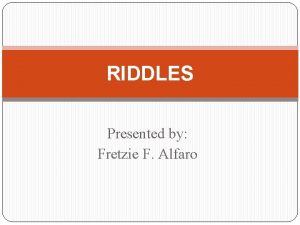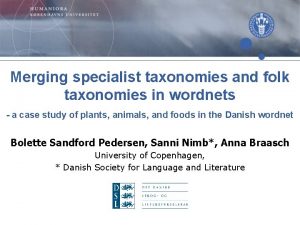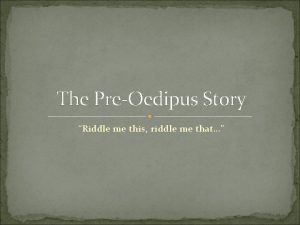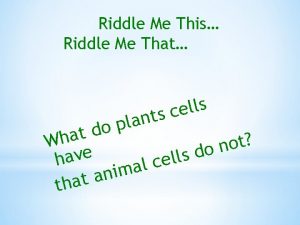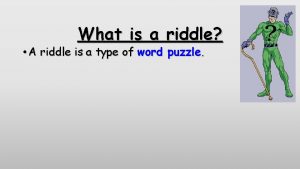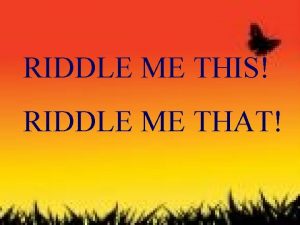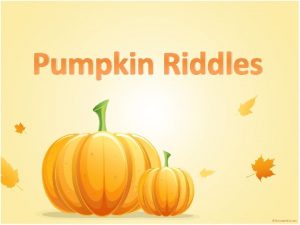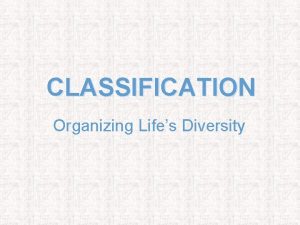Taxonomies and Classification for Organizing Content Prentiss Riddle
























- Slides: 24

Taxonomies and Classification for Organizing Content Prentiss Riddle INF 385 E 9/21/2006

What is a taxonomy? • animal A hierarchical – vertebrates classification system in • mammals which categories are – cat subdivided to create – dog • reptiles finer distinctions. – invertebrates • vegetable • mineral

Not all classification systems are taxonomies Richard Saul Wurman’s LATCH • • • Location Alphabet Time Category Hierarchy Any of these can be expressed as a taxonomy or not. (Well, maybe not the alphabet. . . )

A quibble about definitions • We commonly use “taxonomy, ” “hierarchy” and “classification system” interchangeably but in fact they’re distinct (if overlapping) terms • In particular, a hierarchy can be linear – the “H” in Richard Saul Wurman’s LATCH – elephant > horse > dog > mouse – Maslow’s hierarchy of needs • A “folksonomy” is not a taxonomy!

Why taxonomies? Taxonomies in our heads • Fundamental to cognition • Observed in children from an early age • Long before Linnaeus and Darwin: “folk taxonomies”

Why taxonomies? Taxonomies in the world • Genealogy, phylogeny • Command structures, org charts, territories • Filesystems, domain names, URLs /var/www/people/faculty. php www. ischool. utexas. edu http: //www. ischool. utexas. edu/people/faculty. php

This suggests the use of taxonomies in IA • Taxonomies in support of browsing • Taxonomies in support of search But that’s problematic. . .

Problematic in the world • The world is complicated Who here has had cataloguing? LC Subject Headings, LC Classification, Dewey. . . • The world is even more complicated – Lattices and networks, not trees – Multiple kinds of relationships – Fuzzy boundaries

Problematic in our heads • The taxonomies in our heads don’t match the world • The available taxonomies may not be what’s important anyway – The user doesn’t care about the org chart! (The mantra of enterprise IA) – The user doesn’t care about the filesystem

Cautious use of taxonomies • Tempered by understanding and testing users • Enlist users in creating taxonomies – Techniques like card sorting • Functional or “folk” etymologies preferred over official ones – A gardening site might classify plants by temperature, sun and water needs, not by botanical classification • Make official taxonomies available behind the scenes for use by experts (departmental admins, biology wonks)

Taxonomies in support of browsing “Umbrella architecture” (Rosenfeld & Morville) E. g. , familiar hierarchical menu structures

Taxonomies in support of browsing Not always ideal. . .

Taxonomies in support of browsing. . . but better than chaos. • Supports breadcrumbs • If the users don’t know your taxonomy, gives them a fighting chance to learn it.

Browsing very large taxonomies Yahoo began as a taxonomy company. . . although at some point it became a search (and content) company

Taxonomies in support of search Search results can include a link to a category

Taxonomies in support of search And searches can be limited to a category

Beyond taxonomies

Taxonomies on steroids Taxonomy + controlled vocabulary = thesaurus A thesaurus usually has a taxonomy embedded in it

Relationships in a thesaurus • Some of the links in a thesaurus express hierarchy and links across it – Broader term (BT) – Narrower term (NT) – Related term (RT) • Some express the controlled vocabulary – – Preferred term (PT) Variant term (VT) Use (U) Used for (UF)

Not just synonyms • A thesaurus is not just for synonym rings cat = feline = kitten= kittycat • It’s also for key relationships across the hierarchy “Nice pants! How about a shirt? ” In a sense, Amazon’s many suggestion features and much of Google Adwords are a set of RT links in a thesaurus

Faceted classification A problem inherent in taxonomies is, what gets divided first? – History - U. S. - War - 1812 – War - History - U. S. - 1812 – U. S. - History - 1812 - War Or in more familiar terms: – Wine - Red - California - Dry - 1999 - Under $25 – Wine - Under $25 - Red - Dry - California - 1999 – etc.

Facets are independent hierarchies • Facets work in parallel – In the subject classification example: facets for topic, time, place, etc. – In the wine example: facets for type, origin, price, manufacturer, etc. • A particular item will be at the intersection of several facets • Facets can simplify classification systems both for creators and users


Folksonomies • Fun, powerful, interesting but a misnomer: not taxonomies at all • Tagging systems in use in popular “web 2. 0” sites – www. flickr. com – del. icio. us • Personal keyword metadata aggregated for searching and browsing • The result is not a hierarchy, not really a classification system, certainly not a taxonomy
 John griffith london
John griffith london Larry prentiss
Larry prentiss Here comes kaka walking with an open leg
Here comes kaka walking with an open leg Taxonomies of cultural patterns are
Taxonomies of cultural patterns are Taxonomies of cultural patterns are
Taxonomies of cultural patterns are Navigation taxonomies
Navigation taxonomies Organizing students to interact with new content
Organizing students to interact with new content Real content and carrier content in esp
Real content and carrier content in esp Dynamic content vs static content
Dynamic content vs static content Iso 22301 utbildning
Iso 22301 utbildning Typiska drag för en novell
Typiska drag för en novell Tack för att ni lyssnade bild
Tack för att ni lyssnade bild Ekologiskt fotavtryck
Ekologiskt fotavtryck Varför kallas perioden 1918-1939 för mellankrigstiden?
Varför kallas perioden 1918-1939 för mellankrigstiden? En lathund för arbete med kontinuitetshantering
En lathund för arbete med kontinuitetshantering Adressändring ideell förening
Adressändring ideell förening Tidbok
Tidbok Anatomi organ reproduksi
Anatomi organ reproduksi Förklara densitet för barn
Förklara densitet för barn Datorkunskap för nybörjare
Datorkunskap för nybörjare Tack för att ni lyssnade bild
Tack för att ni lyssnade bild Debattartikel mall
Debattartikel mall Delegerande ledarskap
Delegerande ledarskap Nyckelkompetenser för livslångt lärande
Nyckelkompetenser för livslångt lärande Påbyggnader för flakfordon
Påbyggnader för flakfordon


